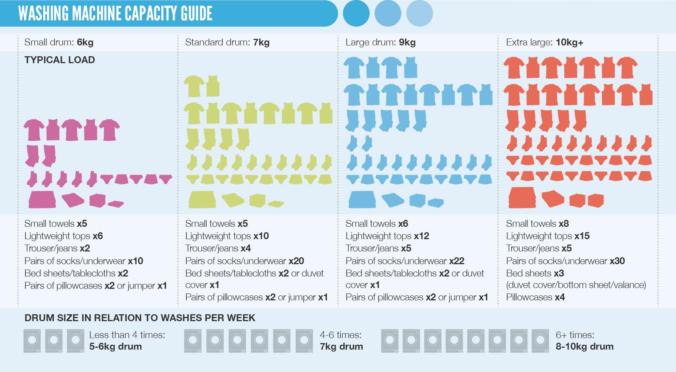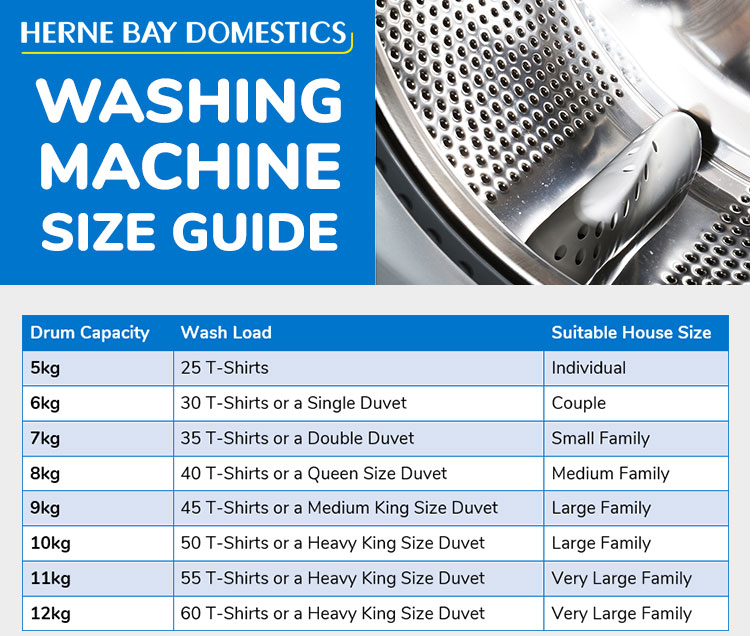


Washing Machine Size Guide 1
When buying a new washing machine, people often talk about the size. But they’re not always talking about the same thing.
Washing machine ‘sizes’ might refer to the machine size – and whether or not it can fit in their home – or the drum size, referring to the capacity of dirty laundry the machine can handle.
It’s important to consider both sizes to make sure you find the perfect machine for your home, that fits perfectly in your kitchen or utility room and has enough drum space to handle the family wash load.
That’s why the appliance experts at LifestyleHomeAppliances have put together this comprehensive guide, giving you the essential information needed to find the best washing machine size for your home.
Measuring Guide: What Size Washing Machine Do I Need?
Before buying a washing machine it’s important to know the dimensions of the machine you need, to avoid buying a machine that is either too big or too small for the space – or that can’t keep pace with your laundry routine.
Below are some simple steps to follow when measuring a washing machine:
Measure the Space Available:
- Measure the washing machine’s installation space – including width, depth and height. Make sure to account for any nooks, cabinets or other obstructions that may limit the size or accessibility of the machine.
- Note the measurements, including the minimum and maximum dimensions the space can accommodate.
Determine the Washing Capacity:
- Consider the typical laundry load you get through. A general guideline is to choose a washing machine with a capacity of 12-16 lbs for a small household (1-2 people) and 16-20 lbs for a larger household (3-4 people).
- Keep in mind that the capacity may be stated in cubic feet or kilograms, so you may have to convert the measurements accordingly.
Check the Machine Dimensions:
- Refer to the specifications of the washing machine models you’re considering. Look for the dimensions, including the width, depth and height.
- Make sure that the machine’s dimensions fit within the available space (measured in step 1). Leave a few inches of clearance on all sides for ventilation and ease of installation.
Consider Additional Features:
- Evaluate the features that are important to you, like energy efficiency, noise level and spin speed. These factors may influence the size and type of washing machine you choose.
For more help finding your perfect washing machine, check out our helpful guide!
Measure the Doorways and Hallways:
- Measure the width and height of any doorways, hallways or other passages the washing machine will need to fit through for installation.
What Is Drum Size on a Washing Machine?
The drum size on a washing machine refers to the internal capacity of the drum, which is where the clothing and laundry items are placed during the wash cycle.
The drum size is typically measured in cubic feet or litres and indicates the maximum load capacity of the machine.
Larger drum sizes allow for washing more clothing at once, making it suitable for larger households or those with higher laundry demands.
How Big Should My Drum Size Be?
The ideal drum size for your washing machine depends on the size of your household and your typical laundry needs. Below are some general guidelines for choosing the right drum size:
Small Household (1-2 people):
- Drum size of 6 – 7kg or 50-80 litres.
Medium Household (3-4 people):
- Drum size of 8 – 9kg or 80-120 litres.
Large Household (5+ people):
- Drum size of 10kg plus or 120-150 litres.
Key factors to consider:
When calculating which washing machine drum size you need, consider the following:
- Your average laundry load size – Larger drum sizes accommodate bigger loads.
- Types of items washed – Bulky items like bedding and blankets need more drum space.
- Frequency of laundry – A higher capacity is better for frequent, large loads.
- Available installation space – Make sure the drum size fits in your laundry area.
Remember, it’s better to have a slightly larger drum size than your current needs, to accommodate future changes in your household size or laundry requirements. This will provide more flexibility and avoid the need to replace the washing machine sooner than you’d like.
Wash Loads vs Washer Size
Below is a table listing the ideal drum capacity for different load types, and the typical recommended household size for each:
Drum Capacity |
Wash Load |
Suitable House Size |
| 5kg | 25 T-Shirts | Individual |
| 6kg | 30 T-Shirts/Single Duvet | Couple |
| 7kg | 35 T-Shirts/Double Duvet | Small Family |
| 8kg | 40 T-Shirts/Queen Size Duvet | Medium Family |
| 9kg | 45 T-Shirts/Medium King-Sized Duvet | Large Family |
| 10kg | 50 T-Shirts/Heavy King Size Duvet | Large Family |
| 11kg | 55 T-Shirts/Heavy King Size Duvet | Very Large Family |
| 12kg | 60 T-Shirts/Heavy King Size Duvet | Very Large Family |
Things To Consider If a Washing Machine Is Too Small or Large
There are several challenges to consider when a washing machine is too large or too small for its designated space. These include:
Too Large
- Difficulty with Placement and Installation: The machine may not fit properly in the allotted space, making it challenging to install or access once in place.
- Restricted Mobility and Access: Limited space can hinder the ability to move the machine for cleaning or maintenance, and accessing features may become more difficult.
- Increased Energy and Water Consumption: Larger drum sizes typically require more energy to operate, even if the drum isn’t full, leading to higher utility costs for smaller loads.
- Reduced Efficiency: Larger machines may often have longer cycle times, even for smaller loads.
- Potential Safety Hazards: Placing a machine in an unsuitable area can pose potential safety risks if it isn’t appropriately installed.
Too Small
- Inadequate Capacity: A machine with a drum size that is too small may not be able to accommodate the household’s typical laundry needs, leading to more frequent loads and longer overall washing times.
- Limited Flexibility: Smaller machines may not be able to handle larger or bulkier items, like bedding or blankets, restricting the types of laundry that can be washed.
- Reduced Lifespan: Repeatedly overloading a small machine can put excessive strain on the components, potentially damaging the appliance long-term.
- Dissatisfaction with Performance: Smaller machines may struggle to provide the desired cleaning results when washing larger loads.
Washing Machines from LifestyleHomeAppliances
Discover the finest selection of kitchen appliances at LifestyleHomeAppliances, where over 70 years of industry expertise meets unparalleled customer service.
Shop our complete range of washing machines – available in various sizes and drum capacities – including compact models that don’t compromise on performance, and larger machines designed to handle all your household laundry needs.
Enjoy personalized guidance, hassle-free installation and dedicated after-sales support – making LifestyleHomeAppliances the trusted choice for all your appliances.








































































































































This size guide is exactly what I needed! I’ve been struggling to figure out what capacity would work best for my family, and now I feel confident about choosing a 9kg front-load washer from Lifestyle Home Appliances. The detailed measurements and tips on how to properly measure my space were super helpful too! Thanks for making the decision easier!